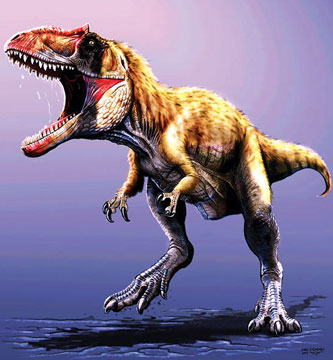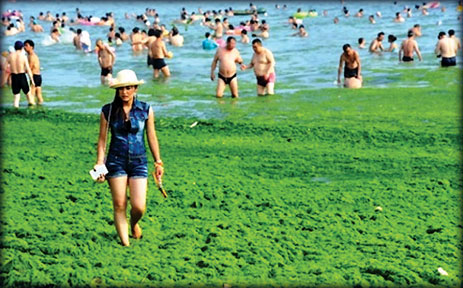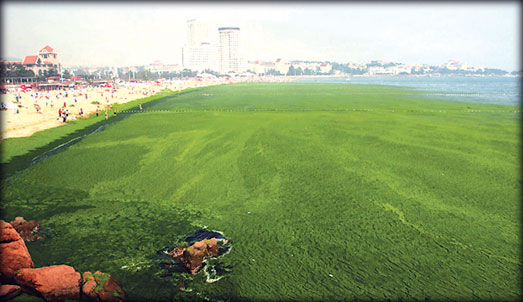|

Gigantic Dino that stalked the planet 100 million years ago
discovered
How would you like to meet a ferocious looking, 30-foot long and four
tons heavy giant carnivorous dinosaur while walking in the nearby
forest? I have my doubts whether you'd like to meet him even in your
dreams. But if you were living about 100 million years ago he would have
been a very common sight.
 North Carolina State University palaeontologists recently discovered
a giant new predatory dinosaur that roamed the Earth about 100 million
years ago and even rivalled the mighty tyrannosaurus Rex. The new
species of carnivorous dinosaur - one of the three largest ever
discovered in North America - lived alongside and competed with
small-bodied tyrannosaurs. North Carolina State University palaeontologists recently discovered
a giant new predatory dinosaur that roamed the Earth about 100 million
years ago and even rivalled the mighty tyrannosaurus Rex. The new
species of carnivorous dinosaur - one of the three largest ever
discovered in North America - lived alongside and competed with
small-bodied tyrannosaurs.
Named after a cannibalistic man-eating monster from Ute tribal
legend, Siats Meekerorumis a species of carcharodontosaur, a group of
giant meat-eaters that includes some of the largest predatory dinosaurs
ever discovered.
It's been 63 years since a predator of this size has been named from
North America," says Lindsay Zanno, a North Carolina State University
palaeontologist working at the North Carolina Museum of Natural
Sciences.
Zanno and colleague Peter Makovicky, from Chicago's Field Museum of
Natural History, discovered the partial skeleton of the new predator in
Utah's Cedar Mountain Formation in 2008.
Although Siats and Acrocanthosaurus are both carcharodontosaurs, they
belong to different sub-groups. Siats is a member of Neovenatoridae, a
more slender-bodied group of carcharodontosaurs. Neovenatorids have been
found in Europe, South America, China, Japan and Australia. However,
this is the first time a neovenatorid has ever been found in North
America.
Siats terrorised what is now Utah during the Late Cretaceous period
(100 million years ago to 66 million years ago). It was previously
unknown who the top meat-eater was in North America during this period.
Carcharodontosaurs reigned for much longer in North America than we
expected," says Zanno.
The lack of fossils left palaeontologists unsure about when this
change happened and if tyrannosaurs out-competed carcharodontosaurs
(carnivorous dinosaurs that existed between 100 and 93 million years
ago) or were simply able to assume apex predator roles following
carcharodontosaur extinction.
It is now clear that Siats' large size would have prevented smaller
tyrannosaurs from taking their place atop the food chain.
"The huge size difference certainly suggests that tyrannosaurs were
held in check by carcharodontosaurs, and only evolved into enormous apex
predators after the carcharodontosaurs disappeared," says Makovicky.
"Contemporary tyrannosaurs would have been no more than a nuisance to
Siats, like jackals at a lion kill. It wasn't until carcharodontosaurs
bowed out that the stage could be set for the evolution of T. Rex."
Zanno adds.
China's largest algal bloom turns the Yellow Sea green
 |
|
Tourists bathe at a
beach covered by a thick layer of green algae in Qingdao,
China. |
What if the Yellow Sea turned green? Now you don't have to imagine
what it would be like. You can see it for real if you go to China.
A massive algal bloom has turned the Yellow Sea green. And other
provinces in China are green with envy as more tourists head to Qingdao
to see the "green" sea.
The largest algal bloom ever recorded in China has turned the Yellow
Sea green and may be related to pollution from agriculture and industry.
Officials in the city of Qingdao had used bulldozers to remove 7,335
tonnes of the growth from beaches.
The phenomenon has become an annual occurrence in the region over the
past six summers.
This year's incident has swathed 28,900 sq km (11,158 sq miles),
twice as much as the previous biggest bloom in 2008.
The algae, called Enteromorphaprolifera, is not toxic to humans or
animals.
However, the carpet on the surface can dramatically change the
ecology of the environment beneath it. It blocks sunlight from entering
the ocean and sucks oxygen from the water suffocating marine life.
The algae thrives on an abundance of nutrients in the sea. University
of Cambridge and En-algae Project researcher Dr Brenda Parker said that
the Chinese bloom may well be linked to industrial pollution.
 |
|
Algae overwhelms a
popular beach in Qingdao, east China. |
"Algal blooms often follow a massive discharge of phosphates or
nitrates into the water. Whether it's farming, untreated sewage or some
kind of industrial plant that is discharging waste into the water," she
said.
The recent explosion of the algae pointed to a dramatic change in the
ecosystem which was probably not natural. "That would probably be an
indicator that something is a little bit unbalanced," said Parker.
But for tourists it is an enjoyable experience. They are bathing from
the famous beaches of China's eastern city of Qingdao despite huge
build-ups of green algae. Many tourists were swimming in water thick
with green algae, or lying on top of it to sunbathe.
It spread across more than 200 square kilometres of sea near Qingdao
by mid-June, making it the most serious invasion of seaweed in the area
since 2008. |

